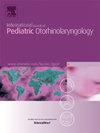避免截骨术和改善健康公平:从范式转变新生儿喂养困难模型的发现
IF 1.2
4区 医学
Q3 OTORHINOLARYNGOLOGY
International journal of pediatric otorhinolaryngology
Pub Date : 2025-04-14
DOI:10.1016/j.ijporl.2025.112355
引用次数: 0
摘要
新生儿喂养困难越来越多地归因于强直性咬合,导致截骨手术激增,尽管有限的高水平证据支持其有效性。在获得适当喂养评估方面的差异会导致潜在的手术过度治疗和护理不公平。目的评价新生儿喂养困难模式转换对临床护理模式和卫生公平的影响。设计、设置和参与者:一项回顾性队列研究,对2017年至2024年在一家三级儿科医院耳鼻喉科门诊就诊的患有强直性咬合相关ICD-9/ICD-10代码的婴儿(6个月)进行队列研究,比较模型前(2017 - 2023)和模型后(2023-2024)队列。主要结果和测量方法主要结果包括经认证的言语语言病理学家(SLP)和哺乳顾问(CLC)评估,耳鼻喉科(ENT)就诊和截骨率。使用多变量logistic回归和中介分析分析可及性和治疗方面的社会人口统计学差异。结果1454例患者中,造模前1171例,造模后283例。模型后患者年龄较大(5.3 vs. 3.6周,P <;0.001),更有可能有公共保险(34.3% vs. 27.4%, P = 0.02),并且SLP/CLC就诊次数增加(50.9% vs. 0.9%, P <;0.001),减少耳鼻喉科就诊(61.8% vs. 99.7%, P <;0.001),且截骨率降低(17.7% vs. 45.4%, P <;0.001)。非英语语言的模型前患者接受截骨术的可能性也较小(AOR: 0.34;p = 0.001)和公共保险(AOR: 0.56;p = 0.002);对于术后患者,这些差异不存在。中介分析表明,该模型将公共保险对SLP/CLC获取的负面影响缓解了54%。实施新生儿喂养困难模型的范式转变导致临床护理模式的重大转变,SLP/CLC服务的利用率增加,腓肠切开术的减少。该模式还改善了公共保险患者获得护理的机会,显示出其在增进卫生公平和优化喂养困难管理方面的潜力。本文章由计算机程序翻译,如有差异,请以英文原文为准。
Avoiding frenotomies and improving health equity: Findings from a paradigm shift newborn feeding difficulties model
Importance
Newborn feeding difficulties are increasingly attributed to ankyloglossia, leading to a surge in frenotomy procedures despite limited high-level evidence supporting its effectiveness. Disparities in access to appropriate feeding assessments contribute to potential surgical overtreatment and inequities in care.
Objective
To evaluate the impact of a paradigm shift newborn feeding difficulties model on clinical care patterns and health equity.
Design, Setting, and Participants
A retrospective cohort study of infants (<6 months) with ankyloglossia-related ICD-9/ICD-10 codes at a tertiary academic pediatric hospital's otolaryngology outpatient clinic between 2017 and 2024, comparing pre-model (2017–2023) and post-model (2023–2024) cohorts.
Main outcomes and measures
Primary outcomes included certified speech-language pathologist (SLP) and lactation consultant (CLC) evaluations, ear, nose, and throat (ENT) visits, and frenotomy rates. Sociodemographic disparities in access and treatment were analyzed using multivariable logistic regression and mediation analysis.
Results
Of 1454 patients, 1171 were pre-model and 283 were post-model. Post-model patients were older (5.3 vs. 3.6 weeks, P < 0.001), more likely to have public insurance (34.3% vs. 27.4%, P = 0.02), and had increased SLP/CLC visits (50.9% vs. 0.9%, P < 0.001), reduced ENT visits (61.8% vs. 99.7%, P < 0.001), and decreased frenotomy rates (17.7% vs. 45.4%, P < 0.001). Pre-model patients were also less likely to receive frenotomy if had non-English language (AOR: 0.34; p = 0.001) and public insurance (AOR: 0.56; p = 0.002); for post-model patients, these disparities were not present. Mediation analysis indicated that the model mitigated the negative effect of public insurance on SLP/CLC access by 54%.
Conclusions and relevance
Implementing a paradigm shift newborn feeding difficulties model resulted in a significant shift in clinical care patterns, with increased utilization of SLP/CLC services and reduced frenotomies. The model also improved access to care for publicly insured patients, demonstrating its potential to enhance health equity and optimize feeding difficulty management.
求助全文
通过发布文献求助,成功后即可免费获取论文全文。
去求助
来源期刊
CiteScore
3.20
自引率
6.70%
发文量
276
审稿时长
62 days
期刊介绍:
The purpose of the International Journal of Pediatric Otorhinolaryngology is to concentrate and disseminate information concerning prevention, cure and care of otorhinolaryngological disorders in infants and children due to developmental, degenerative, infectious, neoplastic, traumatic, social, psychiatric and economic causes. The Journal provides a medium for clinical and basic contributions in all of the areas of pediatric otorhinolaryngology. This includes medical and surgical otology, bronchoesophagology, laryngology, rhinology, diseases of the head and neck, and disorders of communication, including voice, speech and language disorders.

 求助内容:
求助内容: 应助结果提醒方式:
应助结果提醒方式:


